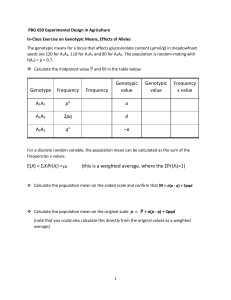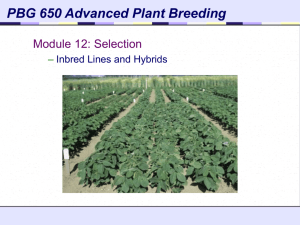Exam 5 Review
advertisement
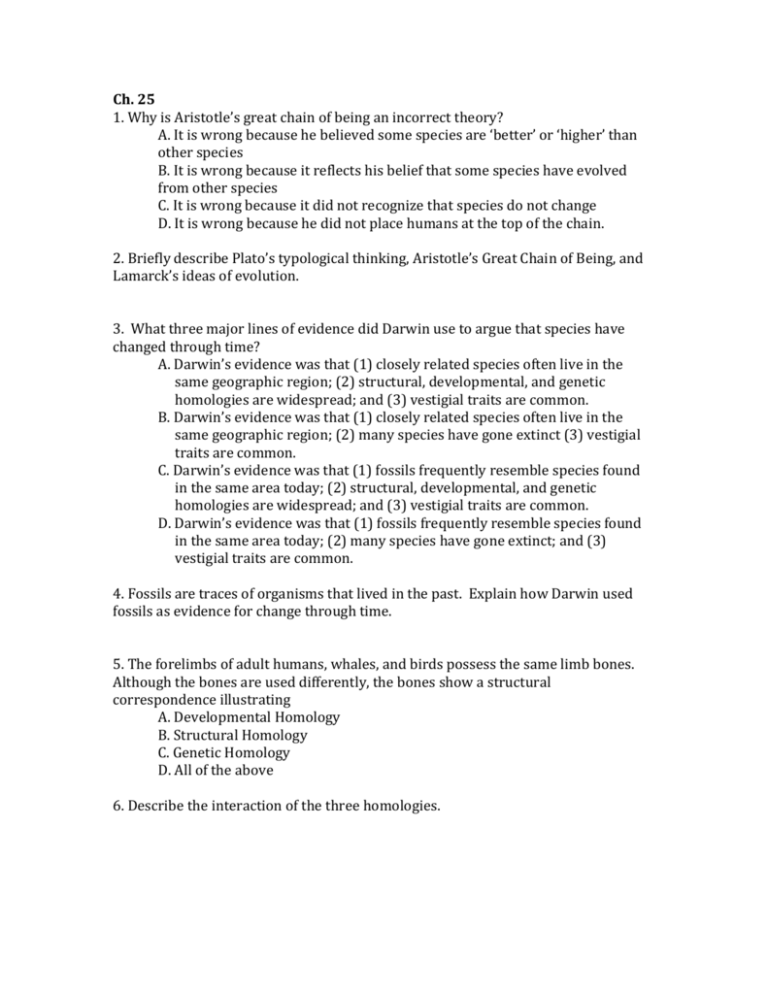
Ch. 25 1. Why is Aristotle’s great chain of being an incorrect theory? A. It is wrong because he believed some species are ‘better’ or ‘higher’ than other species B. It is wrong because it reflects his belief that some species have evolved from other species C. It is wrong because it did not recognize that species do not change D. It is wrong because he did not place humans at the top of the chain. 2. Briefly describe Plato’s typological thinking, Aristotle’s Great Chain of Being, and Lamarck’s ideas of evolution. 3. What three major lines of evidence did Darwin use to argue that species have changed through time? A. Darwin’s evidence was that (1) closely related species often live in the same geographic region; (2) structural, developmental, and genetic homologies are widespread; and (3) vestigial traits are common. B. Darwin’s evidence was that (1) closely related species often live in the same geographic region; (2) many species have gone extinct (3) vestigial traits are common. C. Darwin’s evidence was that (1) fossils frequently resemble species found in the same area today; (2) structural, developmental, and genetic homologies are widespread; and (3) vestigial traits are common. D. Darwin’s evidence was that (1) fossils frequently resemble species found in the same area today; (2) many species have gone extinct; and (3) vestigial traits are common. 4. Fossils are traces of organisms that lived in the past. Explain how Darwin used fossils as evidence for change through time. 5. The forelimbs of adult humans, whales, and birds possess the same limb bones. Although the bones are used differently, the bones show a structural correspondence illustrating A. Developmental Homology B. Structural Homology C. Genetic Homology D. All of the above 6. Describe the interaction of the three homologies. 7. Cetaceans have a phylogeny that indicates a gradual transition between terrestrial and aquatic forms that is supported by several independent sources; this is a form of what? A. Internal consistency B. Genetic correlation C. Acquired characteristics D. None of the above 8. A patient with TB has some mutant bacteria that are resistant to the medication rifampin. After taking the rifampin, the disease re-emerged, and the patient died 10 days later despite antibiotic treatment. Define Darwin’s four postulates and how they relate to this example 9. A silent mutation is a change in the DNA sequence that does not result in a change in amino acid sequence of the protein encoded by the gene, this is an example of what? A. Vestigial trait B. Nonadaptive trait C. Selective trait D. None of the above 10. Explain how genetic correlations occur in genetic constraints Ch. 26 11. What genotype frequencies are expected under Hardy-Weinberg equilibrium for a population with allele frequencies of p=.8 and q=.2 for a particular gene? A. .32, .64, and .04 for A1A1, A1A2, and A2A2 B. .33, .33, and .33 for A1A1, A1A2, and A2A2 C. .64, .32, and .04 for A1A1, A1A2, and A2A2 D. .25, .05, and .25 for A1A1, A1A2, and A2A2 12. What are the assumptions of the Hardy-Weinberg model that make it a null hypothesis? 13. Inbreeding of a heterozygous parent would produce what ratio of homozygous to heterozygous offspring? A. 3:1 B. 1:3 C. 1:2:1 D. None of the above 14. What effects does inbreeding have on a population? 15. Evolution occurs when the allele frequency changes over time within a population. A population of mice is disrupted by a serious drought and the population is severely decreased. This results in a change of genetic variation BEST described by A. Natural selection B. Genetic drift C. Gene flow D. Mutation 16. Explain the differences between natural selection, genetic drift, gene flow, and mutation regarding allele movement 17. Women often have complications during labor while giving birth to very large babies, whereas very small babies tend to be underdeveloped. Which kind of selection is most likely at work regarding the birth weight of babies? A. Directional selection B. Disruptive selection C. Stabilizing selection 18. Explain directional selection, stabilizing selection, disruptive selection and balancing selection. 19. Which of statement most fully characterizes the fundamental asymmetry of sex? A. Female fitness is limited mostly by the ability to attract males, and male fitness is limited by the ability to attract females B. Female fitness is limited mostly by the ability to get resources for producing eggs and rearing young, whereas male fitness is limited by the ability to attract females C. Female fitness is limited mostly by the ability to get resources for producing eggs and rearing young, whereas male fitness is limited by the ability to get resources for provisioning the female D. Female fitness is limited mostly by the ability to attract males, whereas male fitness is limited by the ability to get resources for the female 20. Give an example of females choosing for “good alleles” Ch. 27 21. A species is defined as the smallest monophyletic group on the tree of life. The morphospecies concept identifies species by what? A. A synapomorphy in an observable trait B. Determining the cryptic species traits C. Testing if the species can reproduce D. None of the above 22. Explain the advantages and disadvantages of the biological species concept, the morphospecies concept, and the phylogenetic species concept 23. True or False? A flood that separates a population of frogs onto opposite sides of a lake is an example of a vicariance event that may result in allopatric speciation True False 24. Speciation results from genetic isolation and a lack of gene flow. Explain how this happens in allopatric versus sympatric speciation. 25. Which of the following events would best be described as a case of speciation in sympatry? A. Speciation cannot take place in sympatry, only in allopatry B. A population of lizards is subdivided by a natural barrier and subsequently diverges to form two species that cannot interbreed C. An individual plant undergoes meiotic failure, producing diploid pollen and ovules; these self-fertilize, germinate, and grow into several fully fertile tetraploid plants D. A new, isolated population of fruit flies is founded by a small group of colonists, who then diverge from the ancestral source population 26. Explain how sympatry can happen through ecological niches and through chromosomal changes 27. Which of the following statements about reinforcement is true? A. Reinforcement decreases the morphological differences between two incipient species B. Reinforcement is also called dispersive selection C. Reinforcement increases the number of intermediate phenotypes D. Reinforcement is a type of natural selection 28. Explain how selection works with reinforcement 29. Why was mitochondrial DNA so useful in the study of hybrid zones between Townsend’s warbler and hermit warblers? A. mtDNA is easy to extract, so the researcher could obtain lots of genetic information about the hybrids B. mtDNA is inherited from both parents, like most of the nuclear genetic material. Any gene could have been used in this study. C. mtDNA shows that reinforcement has been occurring within this hybrid zone D. mtDNA is maternally inherited, so the researchers were able to discover that most hybrids resulted from Townsend’s males mating with hermit females 30. How can hybridization create a new species?
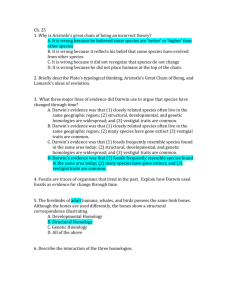
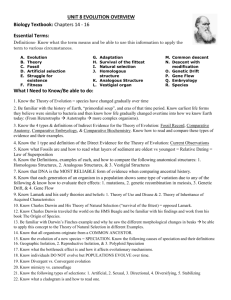

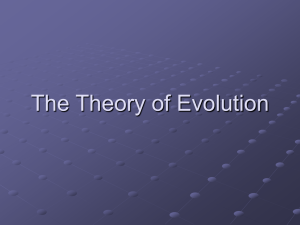
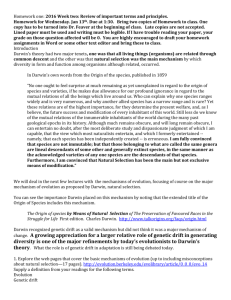
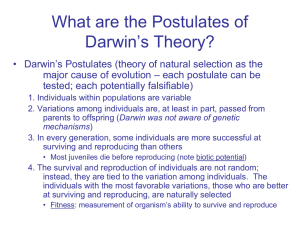



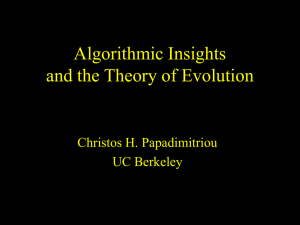

![Evolution Review Sheet [17.5 points]](http://s3.studylib.net/store/data/006844228_1-297d91d8d42ebb7a3d5ae1e01d293b2f-300x300.png)
